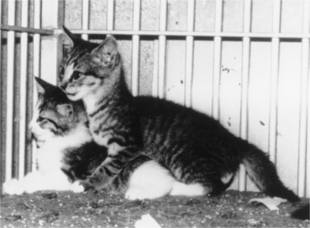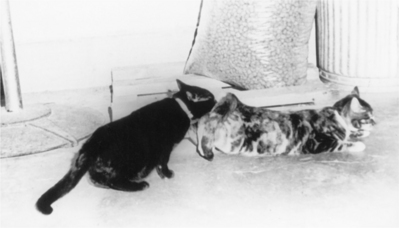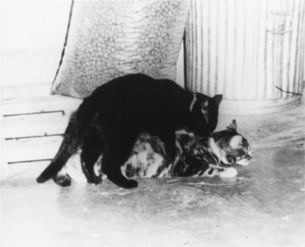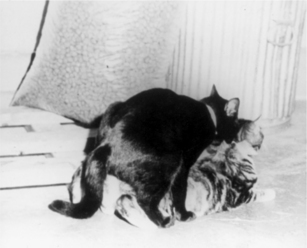Chapter 5 Male Feline Sexual Behavior
Domestication has greatly altered the sexuality of animals, although probably less for dogs and cats than for other species. Sexual behavior is generally intensified and controlled so desired matings can be achieved, particularly in livestock species. Humans have selectively bred dogs for behavioral traits, like scent-tracking ability, or physical characteristics, like short noses or skin wrinkles. Highly successful reproduction has not been a priority for selection. Most feline reproduction has been dependent on the cats themselves with less human impact.
Sexual Maturation
Puberty
Near the time of birth, a surge of testosterone brings about masculinization of neurons that will later direct male feline sexual behavior; however, the Leydig cells remain inactive after this surge until the kitten is approximately 3 months of age.91 By 3 months of age, the male kitten has sufficient testosterone to initiate the growth of penile spines, which reach full size between 6 and 7 months of age. Growth or recession of the spines has been positively correlated with androgen-dependent mating activity.6 By 5 months the kitten’s testes are mature enough for early spermatogenesis, but usually another 1 or 2 months must pass before spermatozoa can be found in the seminal tubules.91
Behavioral sexual maturity, as demonstrated by complete copulations, occurs sometime after sperm enter the seminal tubules, generally between 9 and 12 months (see Appendix D). In the wild, however, cats may not reach this degree of maturity until 18 months of age.11,63 Certain patterns associated with sexual behavior appear before true sexual maturity and are often associated with play. Although young kittens do not commonly mount or perform the neck grip in social play, some males begin mounting, pelvic thrusts, and neck biting as early as 4 months of age (Figure 5-1). They cannot yet achieve intromission, however. Owners are often aware of increased roaming, intermale aggression, and scent marking with urine, all of which accompany the increase in testosterone at puberty.
Reproductive Cycle
Intact males typically leave the homes where they were raised between 1 and 3 years of age.59,71 They have been called “outcasts” if they settle away from other male cats and “challengers” if they are peripheral to other tomcats.71
Male cats are generally regarded as polygamous, fertile, and sexually active throughout the year; however, studies indicate that males do have subtle cyclic patterns. The sexual activity cycle reaches a peak in the spring and a low point during the late fall in the northern hemisphere, when the female is also naturally nonreceptive.5,26,78 This low point may be noticed behaviorally as only a decreased eagerness to mate, so in a breeding operation it is the most difficult time to keep males sufficiently vigorous.78 Changes in sensory feedback from the penis have also been reported in association with reproductive cycles.5
Longevity
Mature male cats not only are likely to show sexual interests beyond their mating capabilities but also are likely to maintain this desire even though reproductive functions may decrease with age.89 Male behavior will usually be evident throughout the animal’s adult life and has been observed in cats 27 years old.23,99
Premating Behavior
Territorial Effect
Once an area is selected, the tomcat often sprays urine on prominent sites. He backs up to objects of about nose level, extends his pelvic limbs, raises his tail, and sprays (see Figure 3-17). He occasionally assumes a front-end–down, rear-end–up posture, possibly to spray higher, and as urine forcefully leaves the caudally directed penis, the tomcat usually wiggles his tail characteristically.98 Other locations may be marked by cheek rubbing.12,66,70 The increased frequency of marking during the mating season may help reassure the male of his surroundings, attract estrous females, and reinforce the resident’s odor for the benefit of wandering males that seem oblivious to territories. Thus marking is associated with response to psychologic disturbances, such as the invasion of territory.
Intermale Aggression
Territorial males become increasingly irritable and protective of their areas during mating season. This is partly because other males wander great distances, with less recognition of territories, interacting with several groups of females.26,71,96 The increased contact between males can result in increased intermale aggression, particularly during encounters between individuals sharing an area. In a home or laboratory setting, irritability is minimized if tomcats can neither see nor hear estrous females and if there are hiding spaces for individuals. Intermale aggression, which is controlled by testosterone, can be violent and even take precedence over sexual behavior. The environment does not seem to be particularly important, and the attack is not provoked except by the physical presence of another intact male.80
After the initial intermale encounter, subsequent meetings usually do not involve fights, and courting males do not fight around estrous females.82 This system generally allows all healthy males a chance to mate an estrous female, with territorial males having the best opportunity, especially for the first mating. Certain territorial males do not permit other males to mate within their area or in their presence, which causes the intruder to flee or become a psychologic castrate. An occasional male does not leave home at sexual maturity but is usually restless in the presence of the resident tomcat.63 Under controlled conditions, one tomcat is usually sufficient for 20 females.32
Courtship
Up to six male cats will follow an estrous female, but only one third of the time is there more than one male present.65 They are attracted by olfactory cues from her urine and vaginal secretions or by her vocalizations. When several males are around, there may be a “central male” that tends to stay much closer and will perform most of the copulations with this female.71,72 At some point, the male then takes the initiative for mating, using either the facial or anogenital approach (Figure 5-2). Thus chin and face rubbing may be more like greeting and courtship behavior than territorial marking.29 Sniffing urine from or the genital area of proestrous and estrous females often results in flehmen, an extension of the head, neck, and upper lip (see Figure 2-8). Because flehmen is more easily elicited by urine from estrous queens than from anestrous ones,95 it probably makes the female estrous odor more accessible to the openings of the vomeronasal organ and associated brain areas. Lack of olfactory ability decreases the time spent smelling the environment and prolongs time used for mating.7,27 A softer mating call, which has been described as an imitation of the female’s “heat cry,” indicates readiness to mate.94 The male usually circles the female before directly approaching her. However, more experienced tomcats may follow the moderate mating call with running directly to the female and initiating mating behavior.29,33,34 An experienced tomcat may run directly to any cat presented in the breeding area and mount, whereas untrained ones may be partial to certain females and ignore others.11 Only one in three healthy males become vigorous reliable breeders, and even testosterone injections are not effective in increasing low sex drive.77
Mating Behavior
Neck Grip
Although each tomcat has an individual style, a general pattern is often seen, with the neck grip the most consistent behavior (Figure 5-3). An experienced tomcat achieves the grip within 16 seconds.97 Biting the skin of the dorsum of the neck is a remnant behavior used to immobilize the female and provide proper orientation for mounting.29,99 The neck grip is not a form of male aggression. In fact, the male is extremely inhibited from showing aggression to an estrous female, and the mating neck bite may represent the inhibited form of the predatory neck bite.31 Even being aggressively struck by a proestrous queen does not elicit retaliation. Rarely does the male’s bite penetrate the skin, and his balance is shifted too far forward to indicate aggression.31 The strong inhibition is probably due to the female’s low posture with more weight carried on the forelimbs, representing a signal to mount, not fight.30,78 The neck grip has been compared with the way a queen carries her kittens and with the lick-grooming behavior.55,68
Copulation
Mounting is the beginning of the mating copulatory sequence. False mounts, those without intromission, do occur, with some males having a higher rate than others.82 False mounts occur normally in many species and may be a way to test receptiveness of the female, to prepare the female for true mounts, or to show dominance, or they may simply represent a failed attempt at copulation.
The tomcat eventually mounts the female, straddling her first with his forelimbs and then with his hindlimbs (Figure 5-4). The treading or stepping movements of the pelvic limbs help the male arch his back and move caudally to position his perineal area for successful intromission. Pelvic thrusts, dorsoventral movements of the pelvic region, begin as he nears the proper posture, and the penis becomes erect. Intromission occurs after a final, slightly more forceful thrust, the pelvic lunge. This is followed by ejaculation. The neck grip is released, the penis withdrawn, and the female rapidly dismounted.
The preliminary positioning-straddling-treading sequence takes 0.3 to 8 minutes.69 The entire mating behavior sequence generally lasts between 1 and 9 minutes, with experienced males achieving intromission in an average of 1.8 minutes.69,85,97 The neck grip–mounting sequence lasts 5 to 50 seconds, and intromission-ejaculation-withdrawal takes only 5 to 18 seconds of this period (mean 8.2 seconds).69,77
Repeated Matings
The pattern of repeated matings between a pair of cats varies considerably with the individuals. After each mating the male goes though a postejaculatory refractory period before mounting again. The duration of this latent period varies from 5 to 15 minutes, increasing after each mating. The female must play a more active role in courtship. If the repeated matings continue long enough, the male may mount without using the neck grip.30 The physiologic component of the postejaculatory refractory period is relatively constant because of its relation with the neural regulation of mating. The psychologic portion is primarily responsible for the changes in refractory time.42,48 Mating enthusiasm can be renewed by introducing a new estrous female during the psychologic phase. Otherwise the fatigue will dissipate within 24 hours. During the first 2 hours, tomcats may copulate three to six times.69 The average number of intromissions per hour is 5.3, with 8.9 mounts during that time.10 In subsequent 2-hour periods the rate drops to 0 to 4 copulations, with the frequency generally not exceeding 15 per 24 hours or 20 to 36 per 36 hours.69,71,72
Miscellaneous Influences
Although experienced tomcats are very eager to mate and may mount anything presented, rape is rare.70 The female’s presentation of an elevated perineum is almost physically essential for intromission to occur.
A male to be used as a stud can be trained through habituation to mount and mate an artificial vagina.78 To condition a tomcat to mate quickly in a colony, one should bring receptive females to him in a special area, allow several matings, and then remove the female first.55
Postmating Behavior
Postmating behavior varies because of the latent period, but the tomcat begins by leaping away from the female’s striking “afterreaction,” which may be accompanied by her growling.29 The male then licks his penis and forepaws before he goes to sit near the female, but out of her clawing distance.
Paternal Behavior
Although most males do not show interest in newborn kittens, there are a few that do. This paternal behavior is probably seen more in the Siamese breed, where the tomcats will lay with and groom the young.11 At the other extreme are tomcats that indiscriminately kill the kittens. This behavior may be an inherited predisposition for bringing the female back into estrus so that the next litter would be sired by that male.45,58 In species that have a high turnover of breeding males, a male has a greater chance of his genes being passed on if he can get females pregnant with his offspring instead of having them use energy resources on the offspring of another male. Infanticide is not as common in domestic cats compared with the large felids, possibly because the female does not actually return to estrus faster.81 Another explanation for infanticide is that the size and shape of the newborn approximate those of natural prey. This appearance then initiates the normal prey-killing instincts of the male, which does not have the hormonal inhibiting influence. He also may mistake the kitten for a crouching female and thus inflict a fatal nape bite.58
Neural Regulation
Brain
The relationship of the brain to male sexual behavior has undergone a great deal of study. As expected, the limbic system, specifically the medial preoptic-rostral hypothalamic region, is primarily responsible. Bilateral ablation of these hypothalamic areas eliminates mounting and pelvic thrusts, a result that is not affected by testosterone.37,41,53 Bilateral removal of the neocortex produces variable results, which probably reflect disturbances in motor coordination rather than deficits in mating behavior. Because these motor capabilities are more important for male mating behavior than for female mating or maternal behavior, differences associated with neocortical control probably reflect the differences in motor needs rather than true sexual neurologic differences.17
Neural and Hormonal Interrelationships
The complex interrelationship between the brain and body hormones complicated many early reports. It has been shown in a number of species that gonadal steroids can have a profound affect on behavior, both with morphogenesis and with specific neuron survival.3 The late prenatal or neonatal male kitten receives a surge of testosterone, which masculinizes the brain. This may be a result of a direct testosterone effect or testosterone converted to estradiol. At the same time, an estrogen-binding plasma protein works to prevent estrogen from entering the brain.3 Without this surge, the infant develops female behavior patterns and responds primarily to female hormones. The differences between males and females are relative, even though they are under a specific hormone’s control.
At maturity, three levels of hormonal control exist.42 Certain hypothalamic nuclei produce gonadotropic-releasing factors that go to the pituitary gland. At the rostral lobe of the pituitary gland, these releasing factors cause production of the gonadotropins: follicle-stimulating hormone (FSH) and luteinizing hormone (LH). FSH and LH work at the testes, where FSH stimulates the production of sperm cells and LH stimulates testosterone production by interstitial cells. Negative feedback mechanisms regulate hypothalamic production so low FSH or LH levels are stimulatory. In castrates, these levels are therefore quite high.42
Spinal Cord and Peripheral Nerves
Part of the male’s sexual behavior is mediated by specific segments of the spinal cord. Spinal transection in the thoracic region may partially affect posturing but not the capacity for erection and ejaculation or associated caudosacral responses.9,22 Erection can be induced by stimulation of the second sacral nerve, and ejaculation is mediated by the lumbosacral spinal cord at the internal pudendal nerves and is triggered by tactile stimulation of the penile body via the dorsal nerve of the penis.8,42,43,87 Androgens appear to intensify low spinal reflexes.8
Sympathetic fibers via the hypogastric nerves cause erection to subside and stop emission of prostatic fluids into the urethra, but the exact roles of the autonomic nervous system are not clearly defined.8
Stay updated, free articles. Join our Telegram channel

Full access? Get Clinical Tree






